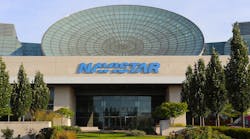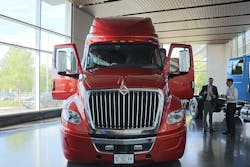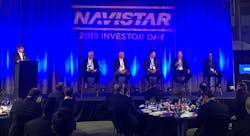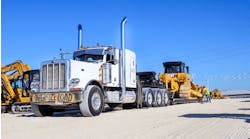LISLE, IL.– Four years ago, at Navistar's last investor day, CEO Troy Clarke was still picking up the mess caused by the previous management team, which went rogue from the industry conventional wisdom and gambled on a high-risk diesel engine for its International trucks that nearly destroyed the prolific company. Clarke, a former General Motors executive, has now been at the helm for six years and the modern-day Odysseus appears to have steered the company out of the maelstrom and potentially back to its rightful place in the trucking pantheon.
“At our last investor day, most of what we presented was related to our turnaround efforts, and at that time we were making a lot of progress,” Clarke said during his opening remarks in the Navistar headquarters conference room, packed with about a hundred financial analysts and consultants. “Even then we began to think about what’s next. We had no interest in being known as the company in perpetual turnaround.”
Clarke shared the aggressive course he’s charted to right the ship heading into the next decade, called the Navistar 4.0 strategy.
This includes building a lean $250 million assembly factory for Classes 6-8 trucks in San Antonio, as well as investing $125 million into the Huntsville, AL, engine plant, producing electrified medium-duty trucks and buses by 2021, and continuing to grow and optimize its telematics to improve driver uptime and total cost of ownership. The San Antonio site, which will create 600 jobs, is expected to reduce logistics and manufacturing costs and ensure faster delivery to customers and strengthen the supply chain between the Escobedo, Mexico plant and southern U.S.
The new plant will also relieve capacity pressure and bust bottlenecks at current factories and help meet demand for the growing medium-duty segment, Clarke said. San Antonio will focus on Class 7’s and pick up Class 8 slack if needed.
The estimated improvements include a 15% reduction in inbound logistics costs, 20% improvement in order to delivery and 20% improvement in first time quality, according to Navistar.
Four-ward March
“Navistar 4.0” is a nod to manufacturing’s Industry 4.0, where customer and production data, advanced tech and cutting-edge efficiency practices merge to create whatever tiny widget or massive machinery the engineers are told to make.
Clarke makes sure to point out this is a “customer-centric,” not “product-centric” approach.
“We were inspired by the vision of a connected environment and the role that more data and analytics would play in this future,” Clarke said.
This is in stark contrast to the manufacturing debacle that cost the company more than $2 billion in R&D, warranty claims, buybacks. Previous longtime CEO Dan Ustian spurned the industry’s universal technology of choice for emissions control—selective catalytic reduction (SCR)— in favor of exhaust gas recirculation (EGR) for the MaxxForce Advanced EGR Engine. After talking up EGR to meet EPA regulations to reduce nitrous oxide emissions, the company realized they wouldn’t meet governmental compliance dates in time, and ran out of carbon credits to leverage. The engineering course-correction to SCR failed and fleets were given defective equipment. About 65,000 trucks were affected and the SEC alleged leadership purposely misled customers and investors.
Navistar is expected to finally bury this elephant in the room by settling the $135 million class-action lawsuit.
Now the only looking back Navistar wants to focus on is the historical data, which ties to tractor and trailer to the factory and vice versa and ensure drivers stay on the road until they shouldn’t.
This connected environment consists of sensors under the hood, near the tires and in-cab, which continuously collect terabytes of information, sent back to Navistar to better understand idling and on-the-road conditions and how the equipment responds to them.
In the plant, product and manufacturing engineers can use these insights to improve quality and performance for future models. Meanwhile, fleet owners can leverage the OnCommand advanced predictive diagnostics tools to assess potential failures and send drivers in for preemptive maintenance before a part fails. If a water pump is starting to go, the system will recognize tell-tale signs and a fleet manager is empowered to tell the driver to get it fixed after the freight drop-off, or pull over immediately, based on the severity of the issue.
A partnership with Love’s enhances this feature, as the 320 service stations are now certified to perform warranty repair under three hours in length. This generally includes alternators, brakes, minor leaks leak, and fuel water separators, according to Jim Nachtman, Navistar marketing director for the heavy-duty segment. Combined with a collection of 700 dealers, Navistar now has what Clarke calls the “largest distribution and service network.”
What that really means is reduced downtime and less time in the shop, as parts and technicians are never too far away. About 80% of work can be done in 24 hours or less.
“Trucks can get on the road quicker and help reduce driver turnover,” Nachtman said. "If they aren’t on the road and earning, drivers may find a new job."
Turnover is about 12 months, and it can cost several thousand to hire a new driver
“And a day of downtime typically costs $1,000 to $1,500 a day,” Nachtman said.
The CEO recognized the global alliance with the TRATON Group (owned by Volkswagen), which has a 17% stake and two board seats, has been critical to the new investments, as the partnership (started in 2016) is poised to yield $500 million in cumulative savings over its first five years. Traton also continues to provide a much-needed European perspective on emissions technology, powertrain development, and parts procurement.
The biggest advantage brought by TRATON is bringing modularity to the truck design and powertrains. Starting from base platforms that include International’s LT, MT, CV, RH trucks, a customer can pick and choose features for vocational or on-highway duty. This allows for a 40% part reduction and 25% productivity gains in engineering and R&D. Navistar has identified 34 different subsegments to cater to.
The plan spelled out to investors would increase EBITDA margins by 50% by 2024, from 8% to 12%, but that can only happen if fleets start buying Internationals in larger numbers again.
Next year is expected to be a down one for Class 8 trucks, and Navistar projects a 30% drop in the segment, though only 10% in medium. Stocks have dropped more than 25% in the last year as well.
Success right now has been measured by regaining the loyalty and goodwill lost due to the EGR scandal.
“Winning for us means sustainable customer relationships,” Clarke said.
Rebuilding Bridges
The night before the investor meeting, a panel of four fleet owners and one dealer took to the stage to discuss how Navistar has improved those relations.
Scott Reed, senior vice president at Werner Enterprises, is putting his fleet’s trust in Navistar, buying 550 new trucks. Werner Enterprises ranks No. 10 on the 2019 Fleet Owner 500 listing of the largest for-hire carriers in the United States and Canada. He was impressed that his salesman had was an engineer by trade.
“He understood equipment I trusted him from the first meeting,” Reed said.
He also has a pragmatic look at the previous troubles.
“Everybody has their turn in the barrel. It’s going to happen,” Reed said. “You’re going to have quality issues, you’re going to have delivery issues. These guys have this turned around.”
And for Clarke, who wouldn’t address any recession speculation but notes trucking and freight are going through a “transition,” that’s enough to build on.
“We are again the company people want to do business with,” Clarke said. “They like our products they like what we’ve done. That’s perhaps the best evidence that things have changed.”







